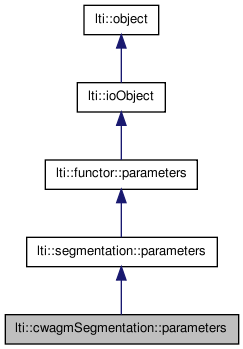

|
latest version v1.9 - last update 10 Apr 2010 |
|
the parameters for the class cwagmSegmentation More...
#include <ltiCWAGMSegmentation.h>


Public Member Functions | |
| parameters () | |
| parameters (const parameters &other) | |
| ~parameters () | |
| const char * | getTypeName () const |
| parameters & | copy (const parameters &other) |
| parameters & | operator= (const parameters &other) |
| virtual functor::parameters * | clone () const |
| virtual bool | write (ioHandler &handler, const bool complete=true) const |
| virtual bool | read (ioHandler &handler, const bool complete=true) |
Public Attributes | |
| regionGraphColorHaris::parameters | harisRegionMergeParam |
Preprocessing | |
| medianFilter::parameters | medianParam |
| bool | enhanceContrast |
Split-Stage with Watersheds | |
| std::string | colorSplitter |
| colorContrastGradient::parameters | colorContrastParam |
| watershedSegmentation::parameters | watershedParam |
| float | minProbForWatershedThreshold |
the parameters for the class cwagmSegmentation
| lti::cwagmSegmentation::parameters::parameters | ( | ) |
default constructor
Reimplemented from lti::segmentation::parameters.
| lti::cwagmSegmentation::parameters::parameters | ( | const parameters & | other | ) |
copy constructor
| other | the parameters object to be copied |
Reimplemented from lti::segmentation::parameters.
| lti::cwagmSegmentation::parameters::~parameters | ( | ) | [virtual] |
destructor
Reimplemented from lti::segmentation::parameters.
| virtual functor::parameters* lti::cwagmSegmentation::parameters::clone | ( | ) | const [virtual] |
returns a pointer to a clone of the parameters
Reimplemented from lti::segmentation::parameters.
| parameters& lti::cwagmSegmentation::parameters::copy | ( | const parameters & | other | ) |
copy the contents of a parameters object
| other | the parameters object to be copied |
Reimplemented from lti::segmentation::parameters.
| const char* lti::cwagmSegmentation::parameters::getTypeName | ( | ) | const [virtual] |
returns name of this type
Reimplemented from lti::segmentation::parameters.
| parameters& lti::cwagmSegmentation::parameters::operator= | ( | const parameters & | other | ) |
copy the contents of a parameters object
| other | the parameters object to be copied |
| virtual bool lti::cwagmSegmentation::parameters::read | ( | ioHandler & | handler, | |
| const bool | complete = true | |||
| ) | [virtual] |
read the parameters from the given ioHandler
| handler | the ioHandler to be used | |
| complete | if true (the default) the enclosing begin/end will be also written, otherwise only the data block will be written. |
Reimplemented from lti::segmentation::parameters.
| virtual bool lti::cwagmSegmentation::parameters::write | ( | ioHandler & | handler, | |
| const bool | complete = true | |||
| ) | const [virtual] |
write the parameters in the given ioHandler
| handler | the ioHandler to be used | |
| complete | if true (the default) the enclosing begin/end will be also written, otherwise only the data block will be written. |
Reimplemented from lti::segmentation::parameters.
Parameters for the computations of the color contrast gradient.
The result is also the input for the watershed algorithm.
Enhance contrast.
If set to true, the dynamic range of the channels will be optimized.
Since the RGB channels will be linearly expanded to map min(R,G,B)-max(R,G,B) to the 0-255 range, the colors of the image will not be severely altered.
Default value: true
Merging parameters for the graph representation.
Watersheds over-segment images. The high number of regions detected slows down the rest of the algorithms. Therefore a first "merging" stage is done, using an adaption of the distance measure suggested by Haris et.al. to also use color images. All adjacent regions with distances under the given threshold will be merged.
A mergeThreshold value close to zero means that only very similar regions have to be merged, while a large value indicates to be much more tolerant while merging and many regions will be merged.
The threshold indicated within this parameter objects indicate a square distance between mean values in the color space weighted by the area of the regions, so that this value will be between 0 and about 1000000, depending on the regions detected. You will usually give values between 0 and 2000
Default: harisRegionMergeParam::mergeThreshold = 1 harisRegionMergeParam::minRegionNumber = 10
A median filter with following parameters is used to denoise the image.
If you don't want any pre-smoothing, indicate a kernel size of 1 or zero and nothing will be done.
Default value: medianParam::kernelSize = 3; medianParam::boundaryType = Constant;
To compute which threshold should be used in the watershed segmentation, the accumulative histogram of gradient values will be used as a probability distribution.
It will be assumed that the probability for a gradient value to be relevant must be greater than the given value.
If you set a value close to zero, almost any gradient value will be detected as edge, and an oversegmentation will be produced.
If you set a value close to one, then only very strong gradient values will be considered, causing an undersegmentation.
The automatic threshold computation will be done only if the user set the watershedParam.threshold to 255.
The value range must be between 0.0f and 1.0f
Default value: 0.45f
Watershed transform parameters.
Default: Rainfall method is selected as default and a 8-Neighborhood. The threshold is set to 255 to activate the automatic threshold detection.